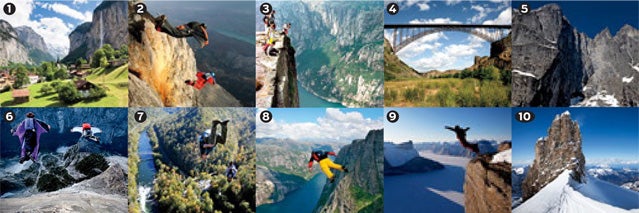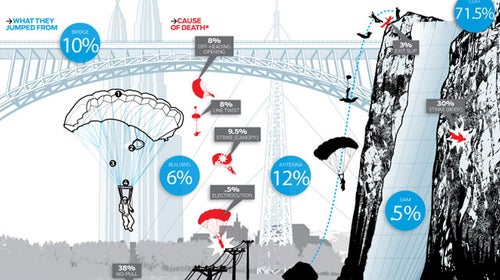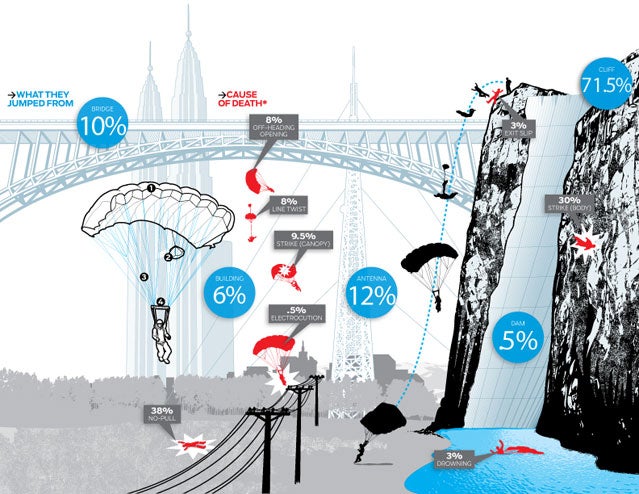Oh, Chute
Miles Daisher, a member of the Red Bull Airforce since 2003, explains . Daisher, 42, has more jumps to his credit than anyone else—he recently passed the 3,000 mark. He teaches newcomers to jump from 486-foot Perrine Bridge, near his home in Twin Falls, Idaho.
The Base Rig Deconstructed
1. Ram-air chute: An inflatable-wing design allows for superior control over the older circular models.2. Pilot chute: Unlike rip-cord parachutes, modern rigs use a small, hand-flung pilot chute that yanks the main chute from its packing.
3. Lines: Every chute has multiple Dacron suspension lines that support the weight of the pilot. Two steering lines guide the canopy left and right and flare the chute during landings.
4. Slider: This rectangular piece of nylon acts as a spoiler, preventing the main chute from opening too quickly and causing spinal injuries.
No-Pull: 38 percent
In a surprising number of fatal BASE accidents, the jumper fails to deploy his or her chute. Sometimes it’s a new jumper who freezes up. Sometimes the container shifts in the wind and the jumper is unable to reach the pilot chute.
Strike (Body): 30 percent
With the rise of wingsuits, more people have taken up proximity flying, in which the jumper pilots a suit along the contours of a less-than-vertical mountain. A wall or ledge strike (like the one that killed Daisher’s colleague Antoine Montant—BFL #179) is exactly what it sounds like.
Strike (Canopy): 9.5 percent
It’s difficult to recover once the canopy has collided with a cliff, guy wire, or building. In the worst cases, the jumper’s body pendulums into the object before falling from the sky. The collision itself can cause plenty of bodily harm.
Off-Heading Opening: 8 percent
The parachute deploys sideways or backward. In a full 180 opening, the chute unfurls in the opposite direction, and the jumper has to spin in his harness to match the canopy’s position. Off-heading openings represent the most dangerous scenario in BASE jumping, because they’re completely random.
Line Twist: 8 percent
Drowning: 3 percent
Exit Slip: 3 percent
Electrocution: 0.5 percent
Deadliest Sites
Where they jump, and how many have died there

BASE Jumping graphic
 How it compares: BASE jumping led the field in deaths in 2011
How it compares: BASE jumping led the field in deaths in 20111. Lauterbrunnen, Switzerland – 28 deaths
2. Mount Brento, Italy – 9 deaths
3. Lysebotn, Norway – 7 deaths
4. Perrine Bridge, Twin Falls, Idaho – 5 deaths
5. Trollveggen, Andalsnes, Norway – 7 deaths
6. Yosemite National Park, California – 7 deaths
7. New River Gorge, Fayetteville, West Virginia – 4 deaths
8. Kjerag, Forsand, Norway – 5 deaths
9. Sam Ford Fjord, Baffin Island, Canada – 2 deaths
10. Engelberg, Switzerland – 2 deaths
Winging It
The rise of wingsuits and tracking suits in BASE jumping

In the early oughts, wingsuits (a.k.a. flying-squirrel suits) and tracking suits (baggy pants and jackets that catch more air) became popular with jumpers who wanted extra glide, both to clear obstacles and to extend free fall.
Summer 1966: Michael Pelkey and Brian Schubert leap from El Capitan with military parachutes. Both men suffer broken bones but survive. Modern BASE jumping is born.
October 1, 1995: American Robert Overacker (BFL #33) attempts to ride a jet-ski off Niagara Falls and parachute to safety. His canopy fails to deploy, and he drowns in the rapids below.
October 22, 1999: Activist Jan Davis (BFL #48) fails to deploy her chute while staging a protest jump from El Cap. The stunt was intended to show rangers that BASE jumping deserves a place in national parks. (It’s banned to this day.)
May 16, 2005: Norwegian Olov Axel Kappfjell (BFL #89) attempts a jump from halfway up the 986-foot Eiffel Tower in honor of Norway’s independence day. He clips a lower level of the tower on the way down and dies.
March 26, 2009: In the Italian Dolomites, ski-film star Shane McConkey (BFL #133) can’t remove his left ski during a wingsuited ski-BASE jump. Before he can recover and deploy his chute, he hits the snow and dies.


